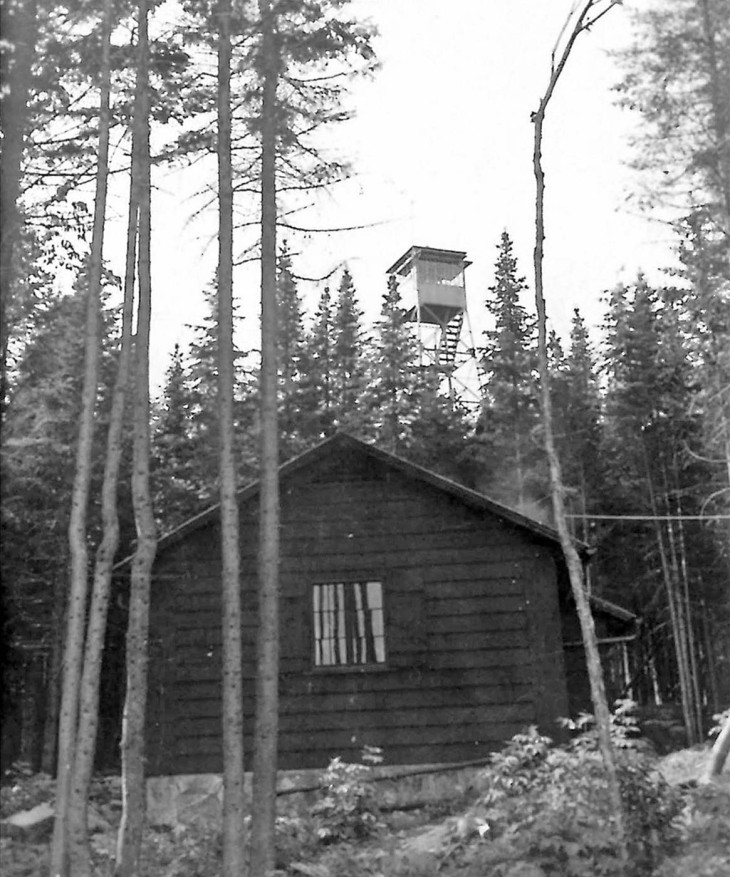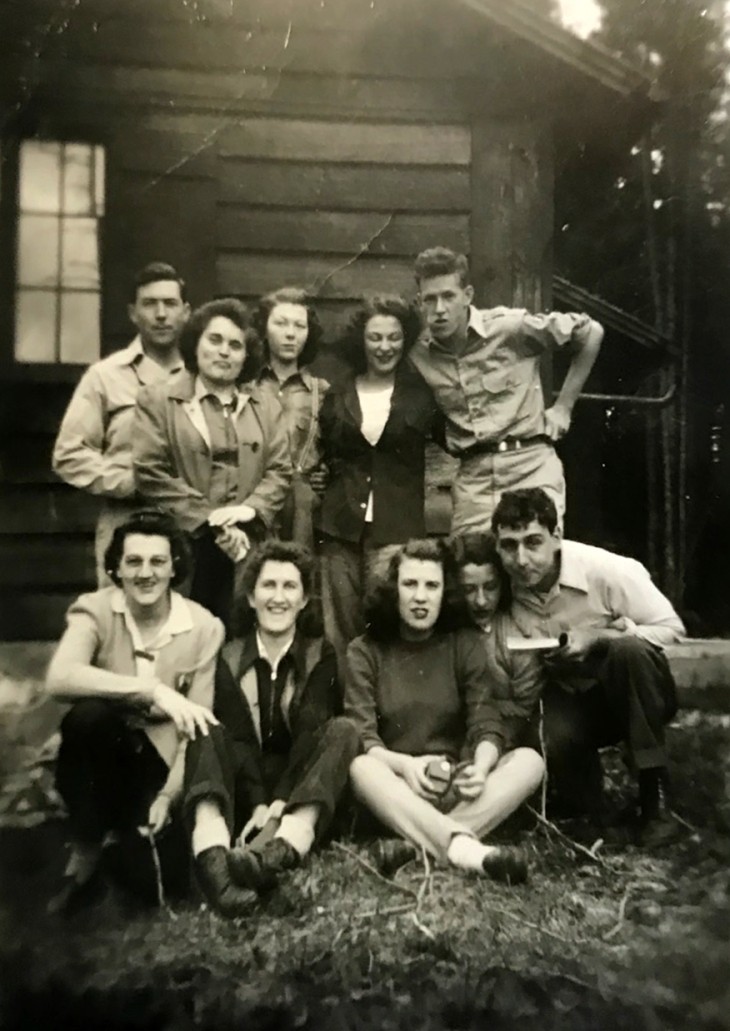During World War II, all across the country, women stepped in to fill jobs traditionally performed by the men who had gone to war. One of these women was Virginia Pearson, who in the summer of 1945, at 19, became a fire lookout on Monadnock Mountain in Vermont’s Northeast Kingdom.
In March of that year, Virginia was working alongside her girlfriends at Ethan Allen Furniture Factory in Beecher Falls, assembling the sturdy maple nightstands to be used in wards at military hospitals and aboard ships. One day, while on her lunch break – and seldom without something to read – Virginia spied an ad for a summer job that was placed in The News and Sentinel: “Wanted: Fire lookouts to man Mount Monadnock fire tower, May – October.”
“What fun!” Virginia recalled thinking, imagining the job would be the perfect way to spend her last summer before leaving for nursing school in the fall. She called her friend, Nadia Fuller, who had just returned from a stint working at a munitions factory in California. While six months on an isolated mountaintop might seem like a nightmare for many young women, Virginia and Nadia considered it a challenging and exciting adventure.
“The state forester wasn’t fazed in the least that we were a couple of girls and said right away we had the job,” Virginia said during an interview in 2018. “He promised to take us up Mount Monadnock in April to see the cabin, the tower and teach us how to read the round topographical map, search for wildfires, and how to call in an alarm. Not once did I think we couldn’t do the job because we were girls. There were so few men around, so who else would do it? And it paid 30 dollars a month!”
Although Virginia lived on a farm just a few miles from Monadnock Mountain in West Stewartstown, New Hampshire, she had never hiked up the 2-mile mountain trail. But like most locals, Virginia was well aware of Monadnock’s dominating presence and the sense of place it provided generations of area residents.
Located in Lemington, in Vermont’s Essex County, the mountain is perched at the northernmost juncture of Vermont and New Hampshire, near the Canadian border. The name Monadnock is derived from an Abenaki word meaning “smooth mountain rising suddenly.” The Connecticut River snakes along the fertile valley below the mountain in an area of undisturbed beauty that, in 1949, then Governor George Aiken dubbed the “Northeast Kingdom.” Eighty percent of the Kingdom, which stretches across Essex, Orleans, and Caledonia counties, is heavily forested.
In late April 1945, Virginia and Nadia reported for work and met the forester at the base of the mountain to begin their trek to the top of Monadnock Mountain. There was still snow on the ground, and they dressed warmly in layers of wool jackets, plaid flannel shirts, dungarees, long underwear, and boots. The trail zigzagged through pastures, then along deep-rutted logging roads and over footbridges made from slippery logs across streams and through dense, dark spruce and balsam fir forests. When they reached the summit, the women surveyed what would be their home for the next several months.
“There was a cabin in great shape with bunk beds, sink, and a wood cook stove,” Virginia said. With a bright smile and sparkling hazel eyes, she recounted the rest of their accoutrement for the summer: an outhouse; two hand-dug springs for drinking water, which they had to carry to the cabin in pails; a hole under the cabin floor that served as a makeshift refrigerator to keep fresh foods cool; and another shallow hole outside, which served as a trash receptacle for tin cans and other refuse that could not be burned.
Although rustic, their living quarters were quite satisfactory. The fire tower was another thing, and their first trip to the top of the 80-foot-high steel structure was one Virginia and Nadia would never forget.
“Every single wood stair tread had been eaten away by porcupines,” said Virginia. “The forester carefully picked his way to the top using the supports as stairs and we followed. At the top of the tower was another small cabin called a shed with a telephone and a round topographical map to help pinpoint where a fire was located. The forester identified various peaks for us – Gore Mountain, Dixville Notch, Stratford Mountain – and Canada.”
For the next six months they would be responsible for watching for signs of forest fires from sunup to sundown from high atop this immense tower. On the first of May that year, Virginia and Nadia moved into the cabin with the help of friends. The group trudged up the trail with everything the women needed in basket backpacks, including bedding, tools, food, clothes, flashlights, matches, axe, shovels, pots, pans, dishes, playing cards, and books.
Once settled in, the women fell into a workable routine.
“We took turns in the tower shed,” Virginia said. “I would climb the tower and patrol the forests with binoculars and answer the daily check-in calls from our neighboring fire towers, and Nadia would make breakfast and clean up. Then we would switch every two hours. At night we cooked dinner and built campfires after. We played cards, sang, and read a lot and marveled at the amazing bright stars and Milky Way.”
After a few weeks of the women climbing the tower on only the stair supports, the state forester returned with a crew carrying new wood treads and tools on their backs to build new stairs.
To prevent the porcupines from chewing through the new stairs, a volunteer came up with his gun and shot 22 porcupines in one night. They also added another telephone in the cabin at ground level. Several times throughout the summer the women had to inspect the telephone lines to ensure the line was stable. “That was quite a chore because the lines did not follow the trail and some of the areas were very steep!” Virginia recalled.
The other firewatchers loved the opportunity to pull jokes on the women with reports that they spotted a bear or mountain lion headed in the women’s direction.
“We played along,” said Virginia. “The old guy based in the Nulhegan Basin area would call us and ask, ‘Did you hear that catamount last night?’ We were never scared. But there was one night we heard a lot of rattling and banging. A skunk had his head caught in a tin can. Nadia held the flashlight and I pulled the can off the skunk. He went in one direction and I went in the other!”
Despite their isolated location, the women received more visitors than any other mountain within their viewsheds.
“We had oodles of visitors! A lot came from the former Monadnock Hotel in Colebrook [New Hampshire], including some European tourists. Youth groups climbed the mountain and picnicked at the top. Many hikers were surprised to find a couple of girls at the top of the mountain, but we didn’t think anything of it. Each week the boys from the nearby junior seminary in Columbia, New Hampshire, hiked up and said Mass and sang us Evensong. Oh it was so beautiful to hear them singing in chorus,” recounted Virginia.
“The only time we were scared is when we were hiking back and got caught in a thunderstorm. Oh my God, the lightning would strike all around us! It was scary but exciting too.”
Virginia said that their tower-watching duties did not slow down their social activities either. They would run down the mountain at sunset on Fridays to attend weekly dances at Marshall’s Cabins (now Jackson’s Lodge) in Wallace Pond, or the KP Hall above Young’s Drugstore and other dances in Stewartstown Hollow, Colebrook, and Island Pond. After a night of dancing they hiked back up before sunrise the next morning carrying up their weekly provisions of milk, eggs, and other groceries in backpack baskets.
“You’d think with all that hiking and climbing the tower I would have lost weight, but I gained 13 pounds that summer!” said Virginia.
According to Ginger Anderson, former forestry district manager for Vermont Forests, Parks & Recreation, fire towers were introduced to wilderness areas in the Northeast during the late 1800s. Usually they were built, manned, and maintained by private logging companies and sportsmen clubs. Devastating forest fires in the region raged in 1903, destroying more than 5,000 acres of Vermont’s forestland, and in 1908 more than 100 individual forest fires scorched nearly 16,000 acres in the state. Shortly after, Vermont established the state Division of Forestry and appointed its first state forester. Organized efforts to prevent forest fires at this time included planting tree seedlings, clearing fallen limbs and trees, erecting fire towers, and assembling forest fire–fighting crews.
By 1909, many new laws were passed with the goal to prevent and detect forest fires earlier. These included requiring locomotives traversing forested areas to burn only oil from April 15 through October 31, preventing the sparks from wood fuel that ignited so many fires. Logging companies were required to limb downed trees left behind. New systems of fire surveillance included building fire towers and hiring state-regulated “patrolmen.” The governor was empowered to close both public and private forests during times of high fire danger.
“In the beginning, in order to protect remote areas, an agreement was struck between logging companies and the state government to set up fire-watching efforts,” said Anderson. “The private logging companies built the fire towers while the state maintained and manned the towers. Essential to building the towers were roads into the wilderness areas and locations of the towers that linked view sheds.” Civil Conservation Corps members were used to clear fallen trees and limbs and to clear and improve trails and roads.
During the summer of 1945, Virginia and Nadia saved the mountain range from three forest fires and gained a deeper appreciation for their homeland.
“We called in three fire alarms!” said Virginia. “And we were the only ones to do so, and the fires were not even in our district. The forest fire we spotted between Stratford and Island Pond was a pretty big one too!”
“The view from the tower was so beautiful,” she said. “I don’t know which I loved more, the sun coming up over the valley in the morning or it setting over the valley at night. And I can tell you the day the church bells rang on August 15 and we got a call that the Japanese surrendered, it took us just 20 minutes to run down the mountain to join in the celebrations! I don’t know how we did it!”
On V-J Day, September 2, 1945, the official end of World War II, Virginia left Monadnock Mountain for Syracuse Nursing School while Nadia stayed at the fire tower until October 1.
When Virginia was on the mountain she was engaged to a local boy, George Carr. He was in the Marine Corps in California preparing to ship out when the war ended. He returned home in 1946, and after Virginia graduated from college in 1948, the two were married. George and Virginia were celebrated local residents who were well known for loving the area where they grew up and raised their children. They celebrated 67 years of marriage before George’s death in 2017 at 92. Virginia died two years later at 93.
Before she passed away, a reminder of her efforts as a wartime firewatcher was delivered to her home in Averill. In 2014, one of the several volunteers who maintain the trail and fire tower, Earl Bunnell, brought Virginia an old wood stair tread from the tower.
A version of this article was published in The News and Sentinel in 2018. For information about the trails and Monadnock Mountain, visit greenmountainclub.org.




